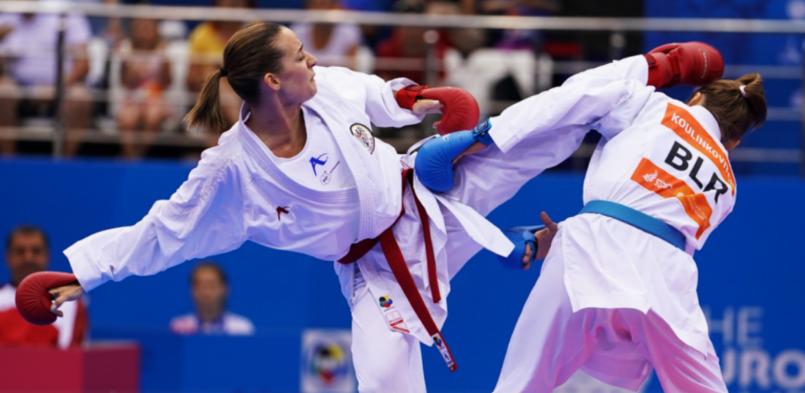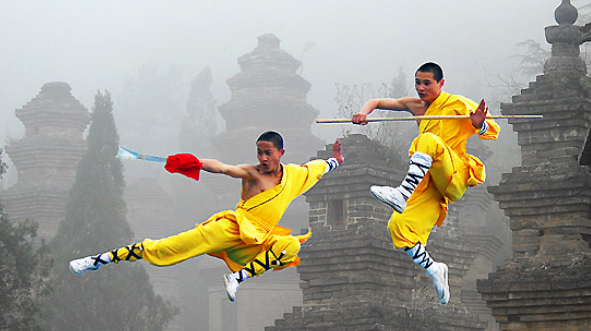In this article, we will explore the differences between two popular martial arts styles: karate and kung fu. Both styles have a rich history and have been practiced for hundreds of years, but they have some key differences that set them apart.
We will look at the origins and histories of each style, as well as their unique approaches to combat and self-cultivation. By the end of this article, you should have a better understanding of the differences between karate and kung fu, and which style might be right for you.
Karate
Karate, also referred to as karate-do has its roots in Okinawa, Japan. It developed over centuries as a blend of local Okinawan fighting styles and Chinese martial arts influences. The term “karate” can be roughly translated to “empty hand,” reflecting its focus on unarmed combat.
The modernization and spread of Karate can be attributed to pioneers like Gichin Funakoshi, who introduced it to mainland Japan in the early 20th century. Gichin Funakoshi is commonly referred to as a “father of modern karate”.
Discipline, respect, and self-control are the major values for Karate. Many dojos (training halls) follow a strict code of conduct. It also promotes the idea that karate should be used for self-defense and not for aggression.

Karate puts emphasis on practical self-defense techniques, teaching students how to defend themselves in real-world situations, including escapes, counters, and disarming opponents.
Karate entails a number of techniques, including strikes, blocks and kicks. These include punches (tsuki), palm strikes (shuto-uchi), and elbow strikes (empi). Common kicks in Karate include front kick (mae geri), roundhouse kick (mawashi geri), and side kick (yoko geri).
It also involves Katas. Katas are choreographed patterns of movements that help practitioners develop precise techniques, balance, and focus. Each style of Karate has its own set of katas, which can range from simple to highly complex sequences.
Proper stances are essential in Karate for stability, mobility, and power generation. Common stances include the front stance (zenkutsu dachi) and horse stance (kiba dachi). Stance work is meticulously practiced to enhance technique execution.
Kumite is an integral part of Karate training, allowing practitioners to apply techniques against a resisting opponent. Controlled sparring sessions help students learn how to adapt and respond to real-life situations.
Karate has numerous styles, each with its own unique techniques, emphasis, and forms. For example, Shotokan emphasizes strong, linear movements, while Goju-Ryu emphasizes circular motions and close combat techniques.
Karate has a colored belt ranking system to indicate a practitioner’s level of skill and experience. The progression from white belt (beginner) to black belt (advanced) involves years of training and mastery of techniques.
Karate practitioners wear a traditional white gi (uniform), which includes a jacket, pants, and a belt. The gi represents the practitioner’s commitment to tradition, discipline, and respect.
While traditional Karate primarily focuses on empty-hand techniques, some styles incorporate weapon training, such as the use of the bo (staff) or nunchaku.
Karate competitions vary in format, including kata competitions, where practitioners perform forms for judges, and kumite competitions, which involve sparring matches. The sport aspect of Karate is included in events like the Olympics, where athletes compete in Kumite and Kata categories.
Kung Fu
Kung Fu is a term used to describe a number of Chinese martial arts practices. It is a term that entails various fighting styles, techniques and philosophies developed and refined over centuries in China. Early Chinese martial arts were developed for self-defense, hunting, and military combat. Kung Fu is not just about combat; it is a holistic system. It involves physical, mental and philosophical elements.
The spread of Kung Fu can be attributed to various factors, including the exchange of knowledge along trade routes, the influence of Taoism and Buddhism, and the proliferation of martial arts schools and systems throughout China. Kung Fu became popularized in the West during the 20th century due to spread of Chinese cinema and the influence of martial arts legends like Bruce Lee and Jackie Chan.

Kung Fu is not just a martial art but a way of life that promotes physical fitness, mental discipline, and personal growth. It has a rich history and continues to evolve as new generations of practitioners explore its depths and adapt it to modern contexts.
Philosophy of Kung Fu
- Daoism (Taoism): The concept of Dao, or the Way, is central to Kung Fu philosophy. It emphasizes the harmony of nature and the need to flow with the natural order of things rather than resisting it.
- Confucianism: Respect, discipline, and moral character are important principles in Confucian thought, which are often integrated into Kung Fu training.
- Zen Buddhism: Mindfulness, meditation, and the cultivation of inner peace are incorporated into many Kung Fu practices.
- Yin and Yang: The balance of opposing forces is a fundamental concept in Kung Fu. This balance is often reflected in the techniques and movements of the martial art.
Training Methods
- Forms (Katas): Forms are choreographed sequences of movements and techniques that help students develop muscle memory, flexibility, and balance. Each style has its unique set of forms.
- Sparring and Combat Drills: Practical application of techniques is essential in Kung Fu. Sparring and partner drills are used to simulate combat scenarios and develop fighting skills.
- Physical Conditioning: Kung Fu practitioners engage in various physical conditioning exercises, including strength training, flexibility training, and endurance exercises.
- Meditation and Qi Gong: Mental and spiritual aspects of Kung Fu are developed through meditation, breathing exercises (Qi Gong), and visualization techniques.
- Weapons Training: Many Kung Fu styles incorporate weapons training, such as staff, sword, nunchaku, and more.
- Philosophical Study: Understanding the philosophical principles of Kung Fu is considered important for personal growth and character development.
Popular Kung Fu Styles
There are many forms of kung fu practiced all over the world. Each form of kung fu has its own principles and techniques, but is best known for its trickery and quickness, which is where the word kung fu is derived.
- Shaolin Kung Fu: Developed at the Shaolin Temple, this style is famous for its rigorous physical training, acrobatic techniques, and emphasis on Buddhist principles.
- Wing Chun: Known for its efficiency and practicality, Wing Chun focuses on close-range combat and trapping techniques.
- Tai Chi: A slow and flowing style that emphasizes balance, relaxation, and the cultivation of internal energy (Qi).
- Jeet Kune Do: Developed by Bruce Lee, Jeet Kune Do is a practical and adaptable martial art that emphasizes simplicity and directness.
- Northern Shaolin: This style incorporates long-range kicks and dynamic movements and is known for its elaborate forms.
- Baguazhang: Known for its circular movements and evasive footwork, Baguazhang is often practiced in conjunction with Qi Gong.
Karate vs Kung Fu: Key Differences
| Aspect | Karate | Kung Fu (Chinese Martial Arts) |
|---|---|---|
| Origin | Japan | China |
| History | Developed in the Ryukyu Kingdom, influenced by Chinese martial arts | Diverse range of Chinese martial arts with deep historical roots |
| Philosophy | Emphasis on linear movements, power, and efficiency | Emphasizes fluid movements, flexibility, and adaptability |
| Techniques | Primarily striking techniques (kicks and punches) | Incorporates a wider variety of techniques, including strikes, kicks, joint locks, throws, and grappling |
| Forms | Katas are a fundamental training method | Forms (or katas) are an important aspect, but with greater variation |
| Styles | Various styles like Shotokan, Wado-Ryu, Goju-Ryu, etc. | Numerous styles including Shaolin, Wing Chun, Tai Chi, and more |
| Training | Focuses on structured, repetitive forms and kumite (sparring) | Training includes forms, sparring, self-defense, and weapons |
| Ranks/Belts | Typically uses a colored belt system to indicate rank | May use colored sashes or other ranking systems |
| Weapons | Usually does not include weapon training | Often includes weapon forms and training (e.g., swords, staffs) |
| Uniform | Practitioners wear a gi (uniform) | Traditional attire may vary by style, such as kung fu uniforms |
| Stance | Often employs a more upright and stable stance | Utilizes a wider variety of stances, some low and fluid |
| Self-defense emphasis | Focused on practical self-defense techniques | Emphasizes self-defense but may include a broader range of techniques |
Key Takeaways
- Karate originated in Okinawa, Japan, while kung fu originated in China.
- Karate emphasizes punches, kicks, and open-handed strikes, while kung fu includes a wider range of techniques, such as grappling, joint locks, and weapons training.
- Karate uses a more linear, direct approach to combat, while kung fu emphasizes fluid, circular movements.
- Karate practitioners typically wear a uniform (gi) and use a belt system to indicate rank, while kung fu practitioners may wear loose-fitting clothing and do not necessarily use a belt system to indicate rank.
- Karate training often focuses on discipline, self-control, and spiritual development, while kung fu training may place more emphasis on physical fitness and self-defense.